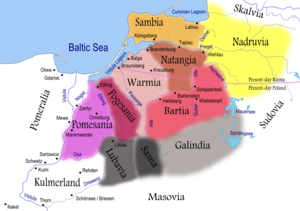Pogesania

Pogesanians and other Prussian clans during the 13th century
|
|
| Total population | |
|---|---|
| Extinct in 17th-18th century | |
| Regions with significant populations | |
| Languages | |
| Old Prussian, later also German | |
| Religion | |
| Prussian mythology (Paganism) | |
| Related ethnic groups | |
| Other Prussians and Balts |
Pogesanians were one of the eleven Prussian clans mentioned by Peter von Dusburg. The clan lived in Pogesania (Lithuanian: Pagudė; German: Pogesanien; Latin: Pogesania; Polish: Pogezania), a small territory stretched between the Elbląg and Pasłęka rivers. It is now located in the Warmian-Masurian Voivodeship, northern Poland. Pogesanians, as the rest of the Prussians, were conquered by the Teutonic Knights and became Germanized or polonized. The old Prussian language became extinct sometime in the 17th century.
In 1237 the Teutonic Order, who had received papal and imperial orders to conquer, Christianize the 'still heathen' Prussians, invaded the region by sea. Elbing (now Elbląg) at the (Ilfing) Elbing River (now Elbląg River) had already been founded by Hanseatic tradesmen from Luebeck. The arrival of the Teutonic Order marked the beginning of the crusade for Pogesanians, as the Knights sought to fulfill the contracts to convert the Prussians to Christianity and to govern the country of Prussia, which was given to them as their property. Pogesanians soon destroyed the city, but the Knights rebuilt it. Elbing remained as one of the Teutonic strongholds and grew to become a port and center of commerce. The city served as the base for further incursions into the Prussian territory. Pogesanians joined other Prussian clans in the First Prussian Uprising (1242–1249). However, they did not sign the Treaty of Christburg and the fighting continued until 1251 or 1252. The Pogesanians were forced to surrender to strong Teutonic reinforcements from Germany.
...
Wikipedia
